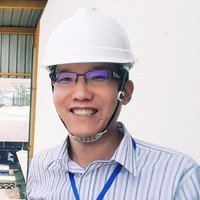PE09 Shell & Tube Heat Exchanger Selection, Design, Specification, Sizing
Artit wiwatwisansakul
Wiroon Tanthapanichakoon
September 24, 2026
Rayong

Artit wiwatwisansakul
Wiroon Tanthapanichakoon
September 24, 2026
Rayong

Shell-and-tube heat exchangers are widely used in process industries due to its robustness and well-established design methods. Process engineers often have to specify shell-and-tube heat exchangers and perform calculations to confirm heat exchanger sizing and sufficiency of heat transfer area. Lack of understanding results in wrong equipment selection and specifications, inability to achieve desired process performance, and even safety issues in operation.
All disciplines of engineers and any technical people who have to design, specify, and operate shell- and-tube heat exchangers for chemical processes.
8:00 AM – 9:00 AM Register
9:00 AM – 12:00 PM
I. Heat Transfer Basic Concepts
• Heat transfer mechanism and basic equations
- Convection
- Conduction
- Radiation
• Heat exchanger flow principles: laminar vs. turbulent
• Heat duty and heat balance for no-phase change and phase change heat exchangers
• Heat transferability diagram developed by Ajarn Charles: Easily understand what parameters determine which types of heat transfer are difficult or easy
II. Shell-and-Tube Heat Exchanger Types and Selection
• TEMA types: fixed tube sheet, floating head, U-tube, kettle type
• Advantages and disadvantages
12:00 PM – 13:00 PM Lunch Break
13:00 PM – 17:00 PM
III. Heat Exchanger Design and Sizing
• Heat exchanger design overall concepts
• Log-Mean Temperature Difference (LMTD) assumptions
• Temperature crossover and F-Factor to Correct LMTD to MTD (effective mean temperature difference)
• Overall heat transfer coefficients (U) with example calculations (U,clean and U,dirty)
• Tube-side heat transfer coefficients
• Tube-side pressure drop
• Temperature profile for all cases of heat transfer
• 3 major sizing methods for shell-side heat transfer coefficients and pressure drop
- Kern method
- Bell-Delaware method
- Flow stream analysis method (Willis-Johnston)
• Thermal rating strategy
• Heat exchanger preliminary rating by simplified Delaware method
• Detailed heat exchanger sizing by Kern method and Bell-Delaware methods
• Heat exchanger – real iterative design calculation example
• Fouling factors
• Resistance analysis for heat exchanger enhancements and improvements
• Heat transfer enhancement concepts and technologies
• Optimum temperature difference for design
• Pressure drop guidelines
• Phase-change heat exchanger design principles
- Condensers
- Reboiler types and configurations
- Steam heat exchanger design concepts
8:00 AM – 9:00 AM Register
9:00 AM – 12:00 PM
IV. Alternative Heat Exchanger Rating Methods
• Effectiveness-NTU method with a real project calculation example
• Temperature span short-cut rating method
V. Heat Exchanger Specifications
• Design pressure and temperature setting: 10/13 rule, 2/3 rule
• TEMA shell, shell head, channel head types and selection
• Heat exchanger TEMA classes: R, C, B
• Tube bundles
• Tube layout and tube pitch
• Maximum number of tube passes
• Baffle types and selection
• Standard tube length
12:00 PM – 13:00 PM Lunch Break
13:00 PM – 17:00 PM
V. Heat Exchanger Specifications (Continued)
• Shell diameter and number of tubes
• Nozzle sizing and locations, flange rating
• Minimum shell and tube thicknesses
• Design guidelines to avoid vibration problems
• Recap of key points in TEMA standard: e.g. Max unsupported tube span, tie-rods
• Tube rolling and tube bundle pulling practices
VI. Example Problems on Shell-and-Tube Heat Exchanger Sizing
• Condenser basic design and sizing
• Reboiler basic design and sizing
• No-phase change heat exchanger basic design and sizing
• HTRI screen-captured simulation examples with explanation of key points

Process Safety Engineering
Process engineering and chemical engineering
Plant problem solving and training

Process & Technology Development
Process engineering
Process scaleup and development
For UPCOMING Public Training Course with ChemEngEdu
Early-Bird Rate for Corporate Participants: 5% discount fromfull price for registration at least 4 weeks (28 days) before the training date(reserve the early-bird rate by registration, not by payment).
Individual Participant Promotion: -50% OFF from full price(max 1 person per organization per course). Not eligible for early-bird rateabove.
Academic Participant Promotion: -40% OFF from full price(max 1 person per organization per course). Not eligible for early-bird rateabove.
SkillLane Participant Promotion: Get 60% OFF the full priceon a CEE course when you register for any SkillLane course. (Offer valid for 1SkillLane course per 1 CEE course.)
Note: Please submit proof of your SkillLane registration toqualify for the discount when signing up.








เราใช้คุกกี้เพื่อพัฒนาประสิทธิภาพ และประสบการณ์ที่ดีในการใช้เว็บไซต์ของคุณ คุณสามารถศึกษารายละเอียดได้ที่ นโยบายความเป็นส่วนตัว และสามารถจัดการความเป็นส่วนตัวเองได้ของคุณได้เองโดยคลิกที่ ตั้งค่า